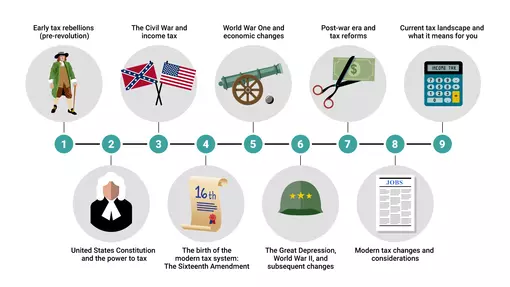The History of Taxes in the United States: A Timeline
Taxes are a fundamental part of any government's operations, used primarily to raise revenue and finance public services. The intricate history of taxes in the United States sheds light on significant political debates, economic challenges, and social implications of different eras. Below we will dive in to the rich tapestry of events that shaped America's approach to taxation.

1. Early tax rebellions (pre-revolution)
Before the establishment of the United States, colonial inhabitants protested against the British Crown's taxes. Notably, the Stamp Act in 1765 (which required American colonists to pay tax to fund British troops stationed in the colonies during the Seven Years' War) and the Boston Tea Party in 1773 (where colonists protested against the Tea Act of 1773, which reduced tax on imported British tea, giving British merchants an unfair tax advantage) showcased the colonies' resistance to direct tax and indirect tax impositions. These notable events set the stage for future tax rebellions in American tax history.
2. United States Constitution and the power to tax
The United States Constitution, ratified in 1788, gave Congress the power to “lay and collect taxes, duties, imposts, and excises.” However, it wasn't until the Civil War, when the need for additional federal revenue became evident, that the first federal income tax was introduced.
3. The Civil War and income tax
To fund the Civil War, Congress passed the Revenue Act of 1861, establishing a commissioner of internal revenue and introducing America's first personal income tax imposed by the federal government. The Act levied a 3% percent tax on incomes between USD 600 and USD 10,000 and a 5% tax on incomes of more than USD 10,000. This early form of income tax was seen by many as a temporary measure. By 1872, Congress repealed this Act, but the concept of a federal income tax had taken root.
4. The birth of the modern tax system: The Sixteenth Amendment
The Sixteenth Amendment was ratified in 1913, granting Congress the power to impose taxes on personal income. It was in this year that the first federal income tax rates were officially set by Congress, and the Internal Revenue Service (IRS) was tasked to collect taxes. Income tax was imposed at a rate of 1% on net personal income above USD 3,000 with a surtax of 6% on incomes above USD 500,000.
5. World War One and economic changes
World War One necessitated an increase in income tax rates. The Revenue Act of 1918 saw the highest marginal tax rate jump dramatically (imposing a progressive income-tax rate structure of up to 77%), marking one of the most substantial hikes in income tax rates historically. As the nation emerged from the war, these federal income tax rates were adjusted in response to economic conditions, laying the groundwork for the system of marginal income tax rates that we're familiar with today.
6. The Great Depression, World War II, and subsequent changes
The 1930s brought about several changes in tax laws. To counteract the economic downturn, the government introduced the estate tax, and the gift tax. World War II further necessitated the increase in federal taxes, with many Americans seeing their income tax rate rise.
7. Post-war era and tax reforms
The post-war era ushered in a series of tax reforms. The Economic Recovery Tax Act of 1981 marked a significant cut in marginal federal income tax rates designed to encourage economic growth. The Tax Reform Act of 1986 aimed to simplify the tax code, reduce tax rates and eliminate many tax shelters. This period also saw the introduction of the Alternative Minimum Tax.
8. Modern tax changes and considerations
The turn of the century brought further adjustments to the tax landscape. The Job Creation Act and the Jobs Act introduced changes primarily aimed at tax relief and economic stimulation. Additionally, debates around the flat tax system and the implications of corporate taxes became prominent.
9. Current tax landscape and what it means for you
Today, the tax code has become immensely complex, covering everything from income tax brackets to excise taxes. People are paying income taxes at varying rates based on their tax bracket, with continuous discussions on what constitutes fair and equitable tax rates.
From the early days of tax rebellions like the Boston Tea Party to the intricate tax code we navigate today, the history of taxes in the United States offers a fascinating look into the nation's economic and political evolution. As we move forward, understanding this history provides the context for future tax debates and changes, ensuring informed decisions for the nation's fiscal future.